Smaller species of swimming marine mammals are often hard to count because they might be present in ones or twos or in groups of hundreds of individuals. Typical survey methods face multiple types of bias when trying to count total numbers because some individuals are missed. For aerial surveys, this is particularly problematic: individuals in a school can be missed because they are diving, too close to other individuals to be seen, or too far away to be detected in photographs or videos. In addition, some observers systematically over-estimate school size while others systematically under-estimate school size. Now a new method has been developed that takes into account all of the uncertainty associated with these various forms of bias, to better estimate school size. When applied to endangered beluga whales in Cook Inlet, Alaska, the new method estimated that only 55% of individuals are near to the surface during each aerial survey pass, and that 2% of whales are concealed by being close to other whales. Group sizes were highly variable from year to year, with large groups of more than 300 whales detected in some years, while in other years there were lots of small groups of whales. The new methods were developed by SAFS research scientist Charlotte Boyd, SAFS professor André Punt, and coauthors from the Marine Mammal Laboratory, NOAA, and appears in the journal Marine Mammal Science.










